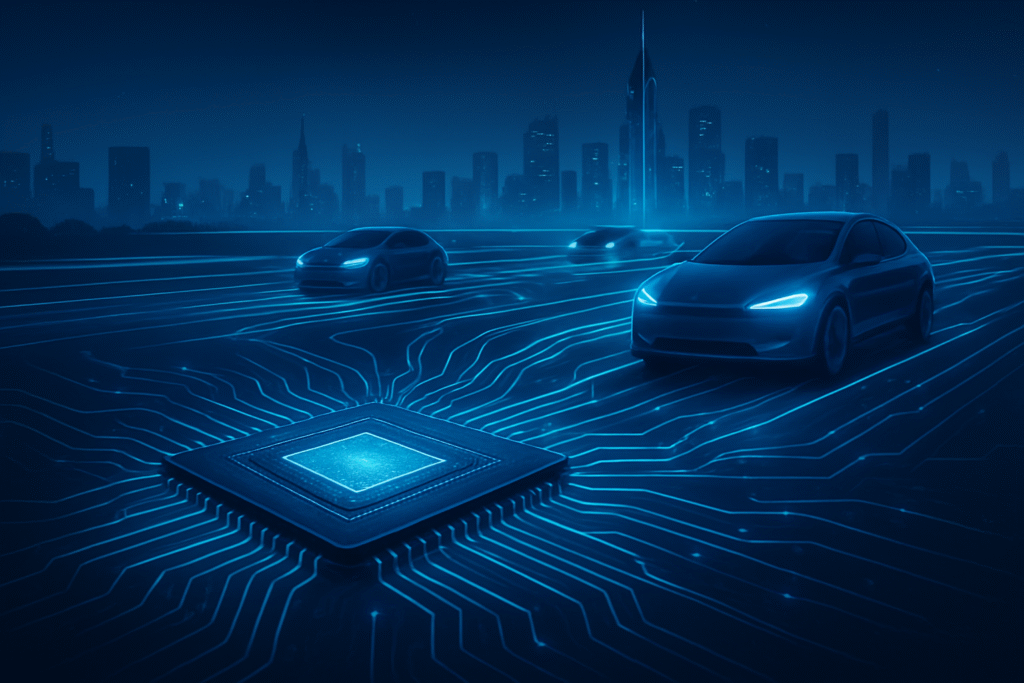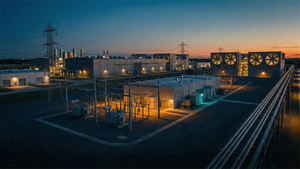
The rapid expansion of autonomous vehicle technologies, spearheaded by industry leader Waymo (NASDAQ: GOOGL), is igniting an unprecedented surge in demand for advanced artificial intelligence chips. As Waymo aggressively scales its robotaxi services across new urban landscapes, the foundational hardware enabling these self-driving capabilities is undergoing a transformative evolution, pushing the boundaries of semiconductor innovation. This escalating need for powerful, efficient, and specialized AI processors is not merely a technological trend but a critical economic driver, reshaping the semiconductor industry, urban mobility, and the broader tech ecosystem.
This growing reliance on cutting-edge silicon holds immediate and profound significance. It is accelerating research and development within the semiconductor sector, fostering critical supply chain dependencies, and playing a pivotal role in reducing the cost and increasing the accessibility of robotaxi services. Crucially, these advanced chips are the fundamental enablers for achieving higher levels of autonomy (Level 4 and Level 5), promising to redefine personal transportation, enhance safety, and improve traffic efficiency in cities worldwide. The expansion of Waymo's services, from Phoenix to new markets like Austin and Silicon Valley, underscores a tangible shift towards a future where autonomous vehicles are a daily reality, making the underlying AI compute power more vital than ever.
The Silicon Brains: Unpacking the Technical Advancements Driving Autonomy
The journey to Waymo-level autonomy, characterized by highly capable and safe self-driving systems, hinges on a new generation of AI chips that far surpass the capabilities of traditional processors. These specialized silicon brains are engineered to manage the immense computational load required for real-time sensor data processing, complex decision-making, and precise vehicle control.
While Waymo develops its own custom "Waymo Gemini SoC" for onboard processing, focusing on sensor fusion and cloud-to-edge integration, the company also leverages high-performance GPUs for training its sophisticated AI models in data centers. Waymo's fifth-generation Driver, introduced in 2020, significantly upgraded its sensor suite, featuring high-resolution 360-degree lidar with over 300-meter range, high-dynamic-range cameras, and an imaging radar system, all of which demand robust and efficient compute. This integrated approach emphasizes redundant and robust perception across diverse environmental conditions, necessitating powerful, purpose-built AI acceleration.
Other industry giants are also pushing the envelope. NVIDIA (NASDAQ: NVDA) with its DRIVE Thor superchip, is setting new benchmarks, capable of achieving up to 2,000 TOPS (Tera Operations Per Second) of FP8 performance. This represents a massive leap from its predecessor, DRIVE Orin (254 TOPS), by integrating Hopper GPU, Grace CPU, and Ada Lovelace GPU architectures. Thor's ability to consolidate multiple functions onto a single system-on-a-chip (SoC) reduces the need for numerous electronic control units (ECUs), improving efficiency and lowering system costs. It also incorporates the first inference transformer engine for AV platforms, accelerating deep neural networks crucial for modern AI workloads. Similarly, Mobileye (NASDAQ: INTC), with its EyeQ Ultra, offers 176 TOPS of AI acceleration on a single 5-nanometer SoC, claiming performance equivalent to ten EyeQ5 SoCs while significantly reducing power consumption. Qualcomm's (NASDAQ: QCOM) Snapdragon Ride Flex SoCs, built on 4nm process technology, are designed for scalable solutions, integrating digital cockpit and ADAS functions, capable of scaling to 2000 TOPS for fully automated driving with additional accelerators.
These advancements represent a paradigm shift from previous approaches. Modern chips are moving towards consolidation and centralization, replacing distributed ECUs with highly integrated SoCs that simplify vehicle electronics and enable software-defined vehicles (SDVs). They incorporate specialized AI accelerators (NPUs, CNN clusters) for vastly more efficient processing of deep learning models, departing from reliance on general-purpose processors. Furthermore, the utilization of cutting-edge manufacturing processes (5nm, 4nm) allows for higher transistor density, boosting performance and energy efficiency, critical for managing the substantial power requirements of L4/L5 autonomy. Initial reactions from the AI research community highlight the convergence of automotive chip design with high-performance computing, emphasizing the critical need for efficiency, functional safety (ASIL-D compliance), and robust software-hardware co-design to tackle the complex challenges of real-world autonomous deployment.
Corporate Battleground: Who Wins and Loses in the AI Chip Arms Race
The escalating demand for advanced AI chips, fueled by the aggressive expansion of robotaxi services like Waymo's, is redrawing the competitive landscape across the tech and automotive industries. This silicon arms race is creating clear winners among semiconductor giants, while simultaneously posing significant challenges and opportunities for autonomous driving developers and related sectors.
Chip manufacturers are undoubtedly the primary beneficiaries. NVIDIA (NASDAQ: NVDA), with its powerful DRIVE AGX Orin and the upcoming DRIVE Thor superchip, capable of up to 2,000 TOPS, maintains a dominant position, leveraging its robust software-hardware integration and extensive developer ecosystem. Intel (NASDAQ: INTC), through its Mobileye subsidiary, is another key player, with its EyeQ SoCs embedded in numerous vehicles. Qualcomm (NASDAQ: QCOM) is also making aggressive strides with its Snapdragon Ride platforms, partnering with major automakers like BMW. Beyond these giants, specialized AI chip designers like Ambarella, along with traditional automotive chip suppliers such as NXP Semiconductors (NASDAQ: NXPI) and Infineon Technologies (ETR: IFX), are all seeing increased demand for their diverse range of automotive-grade silicon. Memory chip manufacturers like Micron Technology (NASDAQ: MU) also stand to gain from the exponential data processing needs of autonomous vehicles.
For autonomous driving companies, the implications are profound. Waymo (NASDAQ: GOOGL), as a pioneer, benefits from its deep R&D resources and extensive real-world driving data, which is invaluable for training its "Waymo Foundation Model" – an innovative blend of AV and generative AI concepts. However, its reliance on cutting-edge hardware also means significant capital expenditure. Companies like Tesla (NASDAQ: TSLA), Cruise (NYSE: GM), and Zoox (NASDAQ: AMZN) are similarly reliant on advanced AI chips, with Tesla notably pursuing vertical integration by designing its own FSD and Dojo chips to optimize performance and reduce dependency on third-party suppliers. This trend of in-house chip development by major tech and automotive players signals a strategic shift, allowing for greater customization and performance optimization, albeit at substantial investment and risk.
The disruption extends far beyond direct chip and AV companies. Traditional automotive manufacturing faces a fundamental transformation, shifting focus from mechanical components to advanced electronics and software-defined architectures. Cloud computing providers like Google Cloud and Amazon Web Services (AWS) are becoming indispensable for managing vast datasets, training AI algorithms, and delivering over-the-air updates for autonomous fleets. The insurance industry, too, is bracing for significant disruption, with potential losses estimated at billions by 2035 due to the anticipated reduction in human-error-induced accidents, necessitating new models focused on cybersecurity and software liability. Furthermore, the rise of robotaxi services could fundamentally alter car ownership models, favoring on-demand mobility over personal vehicles, and revolutionizing logistics and freight transportation. However, this also raises concerns about job displacement in traditional driving and manufacturing sectors, demanding significant workforce retraining initiatives.
In this fiercely competitive landscape, companies are strategically positioning themselves through various means. A relentless pursuit of higher performance (TOPS) coupled with greater energy efficiency is paramount, driving innovation in specialized chip architectures. Companies like NVIDIA offer comprehensive full-stack solutions, encompassing hardware, software, and development ecosystems, to attract automakers. Those with access to vast real-world driving data, such as Waymo and Tesla, possess a distinct advantage in refining their AI models. The move towards software-defined vehicle architectures, enabling flexibility and continuous improvement through OTA updates, is also a key differentiator. Ultimately, safety and reliability, backed by rigorous testing and adherence to emerging regulatory frameworks, will be the ultimate determinants of success in this rapidly evolving market.
Beyond the Road: The Wider Significance of the Autonomous Chip Boom
The increasing demand for advanced AI chips, propelled by the relentless expansion of robotaxi services like Waymo's, signifies a critical juncture in the broader AI landscape. This isn't just about faster cars; it's about the maturation of edge AI, the redefinition of urban infrastructure, and a reckoning with profound societal shifts. This trend fits squarely into the "AI supercycle," where specialized AI chips are paramount for real-time, low-latency processing at the data source – in this case, within the autonomous vehicle itself.
The societal impacts promise a future of enhanced safety and mobility. Autonomous vehicles are projected to drastically reduce traffic accidents by eliminating human error, offering a lifeline of independence to those unable to drive. Their integration with 5G and Vehicle-to-Everything (V2X) communication will be a cornerstone of smart cities, optimizing traffic flow and urban planning. Economically, the market for automotive AI is projected to soar, fostering new business models in ride-hailing and logistics, and potentially improving overall productivity by streamlining transport. Environmentally, AVs, especially when coupled with electric vehicle technology, hold the potential to significantly reduce greenhouse gas emissions through optimized driving patterns and reduced congestion.
However, this transformative shift is not without its concerns. Ethical dilemmas are at the forefront, particularly in unavoidable accident scenarios where AI systems must make life-or-death decisions, raising complex moral and legal questions about accountability and algorithmic bias. The specter of job displacement looms large over the transportation sector, from truck drivers to taxi operators, necessitating proactive retraining and upskilling initiatives. Safety remains paramount, with public trust hinging on the rigorous testing and robust security of these systems against hacking vulnerabilities. Privacy is another critical concern, as connected AVs generate vast amounts of personal and behavioral data, demanding stringent data protection and transparent usage policies.
Comparing this moment to previous AI milestones reveals its unique significance. While early AI focused on rule-based systems and brute-force computation (like Deep Blue's chess victory), and the DARPA Grand Challenges in the mid-2000s demonstrated rudimentary autonomous capabilities, today's advancements are fundamentally different. Powered by deep learning models, massive datasets, and specialized AI hardware, autonomous vehicles can now process complex sensory input in real-time, perceive nuanced environmental factors, and make highly adaptive decisions – capabilities far beyond earlier systems. The shift towards Level 4 and Level 5 autonomy, driven by increasingly powerful and reliable AI chips, marks a new frontier, solidifying this period as a critical phase in the AI supercycle, moving from theoretical possibility to tangible, widespread deployment.
The Road Ahead: Future Developments in Autonomous AI Chips
The trajectory of advanced AI chips, propelled by the relentless expansion of autonomous vehicle technologies and robotaxi services like Waymo's, points towards a future of unprecedented innovation and transformative applications. Near-term developments, spanning the next five years (2025-2030), will see the rapid proliferation of edge AI, with specialized SoCs and Neural Processing Units (NPUs) enabling powerful, low-latency inference directly within vehicles. Companies like NVIDIA (NASDAQ: NVDA), Qualcomm (NASDAQ: QCOM), and Intel (NASDAQ: INTC) /Mobileye will continue to push the boundaries of processing power, with chips like NVIDIA's Drive Thor and Qualcomm's Snapdragon Ride Flex becoming standard in high-end autonomous systems. The widespread adoption of Software-Defined Vehicles (SDVs) will enable continuous over-the-air updates, enhancing vehicle adaptability and functionality. Furthermore, the integration of 5G connectivity will be crucial for Vehicle-to-Everything (V2X) communication, fostering ultra-fast data exchange between vehicles and infrastructure, while energy-efficient designs remain a paramount focus to extend the range of electric autonomous vehicles.
Looking further ahead, beyond 2030, the long-term evolution of AI chips will be characterized by even more advanced architectures, including highly energy-efficient NPUs and the exploration of neuromorphic computing, which mimics the human brain's structure for superior in-vehicle AI. This continuous push for exponential computing power, reliability, and redundancy will be essential for achieving full Level 4 and Level 5 autonomous driving, capable of handling complex and unpredictable scenarios without human intervention. These adaptable hardware designs, leveraging advanced process nodes like 4nm and 3nm, will provide the necessary performance headroom for increasingly sophisticated AI algorithms and predictive maintenance capabilities, allowing autonomous fleets to self-monitor and optimize performance.
The potential applications and use cases on the horizon are vast. Fully autonomous robotaxi services, expanding beyond Waymo's current footprint, will provide widespread on-demand driverless transportation. AI will enable hyper-personalized in-car experiences, from intelligent voice assistants to adaptive cabin environments. Beyond passenger transport, autonomous vehicles with advanced AI chips will revolutionize logistics through driverless trucks and significantly contribute to smart city initiatives by improving traffic flow, safety, and parking management via V2X communication. Enhanced sensor fusion and perception, powered by these chips, will create a comprehensive real-time understanding of the vehicle's surroundings, leading to superior object detection and obstacle avoidance.
However, significant challenges remain. The high manufacturing costs of these complex AI-driven chips and advanced SoCs necessitate cost-effective production solutions. The automotive industry must also build more resilient and diversified semiconductor supply chains to mitigate global shortages. Cybersecurity risks will escalate as vehicles become more connected, demanding robust security measures. Evolving regulatory compliance and the need for harmonized international standards are critical for global market expansion. Furthermore, the high power consumption and thermal management of advanced autonomous systems pose engineering hurdles, requiring efficient heat dissipation and potentially dedicated power sources. Experts predict that the automotive semiconductor market will reach between $129 billion and $132 billion by 2030, with AI chips within this segment experiencing a nearly 43% CAGR through 2034. Fully autonomous cars could comprise up to 15% of passenger vehicles sold worldwide by 2030, potentially rising to 80% by 2040, depending on technological advancements, regulatory frameworks, and consumer acceptance. The consensus is clear: the automotive industry, powered by specialized semiconductors, is on a trajectory to transform vehicles into sophisticated, evolving intelligent systems.
Conclusion: Driving into an Autonomous Future
The journey towards widespread autonomous mobility, powerfully driven by Waymo's (NASDAQ: GOOGL) ambitious robotaxi expansion, is inextricably linked to the relentless innovation in advanced AI chips. These specialized silicon brains are not merely components; they are the fundamental enablers of a future where vehicles perceive, decide, and act with unprecedented precision and safety. The automotive AI chip market, projected for explosive growth, underscores the criticality of this hardware in bringing Level 4 and Level 5 autonomy from research labs to public roads.
This development marks a pivotal moment in AI history. It signifies the tangible deployment of highly sophisticated AI in safety-critical, real-world applications, moving beyond theoretical concepts to mainstream services. The increasing regulatory trust, as evidenced by decisions from bodies like the NHTSA regarding Waymo, further solidifies AI's role as a reliable and transformative force in transportation. The long-term impact promises a profound reshaping of society: safer roads, enhanced mobility for all, more efficient urban environments, and significant economic shifts driven by new business models and strategic partnerships across the tech and automotive sectors.
As we navigate the coming weeks and months, several key indicators will illuminate the path forward. Keep a close watch on Waymo's continued commercial rollouts in new cities like Washington D.C., Atlanta, and Miami, and its integration of 6th-generation Waymo Driver technology into new vehicle platforms. The evolving competitive landscape, with players like Uber (NYSE: UBER) rolling out their own robotaxi services, will intensify the race for market dominance. Crucially, monitor the ongoing advancements in energy-efficient AI processors and the emergence of novel computing paradigms like neuromorphic chips, which will be vital for scaling autonomous capabilities. Finally, pay attention to the development of harmonized regulatory standards and ethical frameworks, as these will be essential for building public trust and ensuring the responsible deployment of this revolutionary technology. The convergence of advanced AI chips and autonomous vehicle technology is not just an incremental improvement but a fundamental shift that promises to reshape society. The groundwork laid by pioneers like Waymo, coupled with the relentless innovation in semiconductor technology, positions us on the cusp of an era where intelligent, self-driving systems become an integral part of our daily lives.
This content is intended for informational purposes only and represents analysis of current AI developments.
TokenRing AI delivers enterprise-grade solutions for multi-agent AI workflow orchestration, AI-powered development tools, and seamless remote collaboration platforms.
For more information, visit https://www.tokenring.ai/.

















